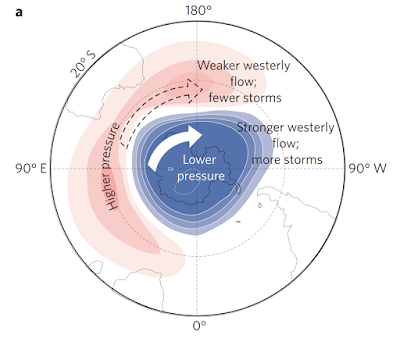With an alpine topography
and summer air temperatures frequently above freezing, the Antarctic Peninsula has a very different environment from the rest of the continent. The East Antarctic ice sheet (EAIS) is considerably larger and cooler than the Peninsula, with thicker ice and fewer ice free areas. Temperatures in East Antarctica have shown little change over the last century.
The Antarctic Peninsula's small size, higher latitude and other environmental factors make it particularly vulnerable to climate change. Between 1950 and 2000 it was reported that surface temperatures increased by 2.5°C and the surrounding oceans warmed.
The Antarctic Peninsula's small size, higher latitude and other environmental factors make it particularly vulnerable to climate change. Between 1950 and 2000 it was reported that surface temperatures increased by 2.5°C and the surrounding oceans warmed.
 |
| The Antarctic Peninsula (Image: NASA) |
Wind Matters
The Southern Annual Mode (SAM), is one of the main controllers of climate in Antarctica as it affects the movement of westerlies that circulate the continent. Since the 1960's the SAM has been in its positive phase, resulting in reduced pressures and enhanced westerlies over the Antarctic Peninsula.
 |
| The SAM in its positive phase is characterised by a decrease in pressure over Antarctica (Image: Jones, 2012) |
The IPCC has reported that this positive phase has contributed to strong summer warming and reduced sea ice flow in the region. It has been suggested that this positive shift in the SAM could be partly attributed to increases in atmospheric greenhouse gases (IPCC, 2007). In fact, Abram et al., 2015 reproduced this positive trend using multi-model climate simulations coupled with rising greenhouse gases.
So atmospheric temperatures have risen, oceans have warmed and the SAM has shifted into a positive phase, but what does this mean for the Peninsula?
The Ice is Thinning
A study by Vaughan et al., 2003 reported that seven major ice shelves were retreating during the second half of the twentieth century over the Antarctic Peninsula; the IPCC has stated that the confidence that this is caused by atmospheric warming is high. In 2002 the collapse of the Larsen B ice shelf made headline news. The break down of this buttressing ice shelf, which acts as a dam to the flow of glaciers into the sea, has been linked to increases in glacial surges. In fact, observations after this event showed that the Hektoria, Green and Evans glaciers accelerated eightfold.
Other glaciers have also been receding: a study which examined 244 glaciers in the region found that 212 had been retreating, shown on the left in the figure below, and those that had been advancing were doing so at a much slower rate.
 |
| Overall changes in Antarctic Peninsula glacier fronts since 1940. Far more glaciers have retreated (A) than advanced (B) (Image: Cook et al 2005) |
The Antarctic Peninsula has unequivocally warmed and according to the IPCC the observed changes to ice shelves and glaciers are irreversible. Next week I will be examining the evidence of climate change in the East Antarctic Ice Sheet: stay tuned to find out more!




No comments:
Post a Comment